The Top 20 NBA Draft Prospects in the Pac-12 Conference
The Top 20 NBA Draft Prospects in the Big 12 Conference
The Top 10 NBA Draft Prospects in the AAC Conference
The Top 22 NBA Draft Prospects in the SEC Conference
The Top 10 NBA Draft Prospects in the Big East Conference
The Top 20 NBA Draft Prospects in the Big Ten Conference
Top NBA Prospects in the ACC, Part 1
(#1) Jahlil Okafor (Scouting Video)
Top NBA Prospects in the ACC, Part 2
(#2) Justise Winslow (Scouting Video)
Top NBA Prospects in the ACC, Part 3
(#3) Montrezl Harrell (Scouting Video)
Top NBA Prospects in the ACC, Part 4
(#4) Tyus Jones (Scouting Video)
Top NBA Prospects in the ACC, Part 5
(#5) Brice Johnson (Scouting Video)
Top NBA Prospects in the ACC, Part 6
(#6) Marcus Paige (Scouting Video)
Top NBA Prospects in the ACC, Part 7
(#7) Theo Pinson
(#8) Justin Jackson
(#9) Terry Rozier
(#10) Jerian Grant
(#11) Kennedy Meeks
#12, Rasheed Sulaimon, 6'5, Shooting Guard, Duke, Junior
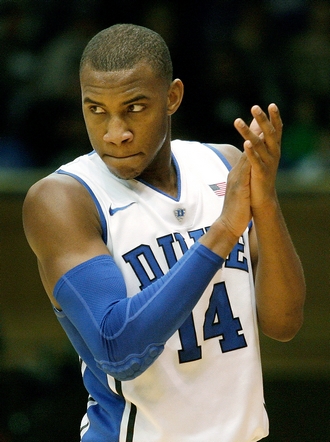
Kyle Nelson
Rasheed Sulaimon is no stranger to high expectations. Arriving at Duke as a McDonald's All-American and the 15th ranked player in his high school class, Sulaimon had a good freshman year for a Duke team that made a deep NCAA Tournament run. His sophomore year marked a bit of a step back, however, as Jabari Parker and Rodney Hood's arrival redefined Duke's offensive identity and relegated Sulaimon to a variety of roles as a starter and off the bench.
Even though Sulaimon had an inconsistent sophomore season, he saved his best basketball for last, logging 12.4 points per game during his last five games, ending in a 20 point effort that ultimately failed to help Duke avoid yet another NCAA upset. While Sulaimon's efficiency inside the arc may have waned and his overall productivity stagnated, he once again displayed the same combination of offensive versatility and defensive tenacity that made him an intriguing prospect in the first place. As Duke prepares to insert a trio of 5-star freshmen into the rotation, Coach Mike Krzyzewski will need Sulaimon to shake off his inconsistent sophomore season and hit his stride as a junior.
At 6'4 ½ in shoes with a 195-pound frame and a 6'7 wingspan, Sulaimon has just decent size for the shooting guard position. He is a good, not great athlete on top of that, quick and agile in the open floor and off the dribble, while showing the ability to change directions, stop on a dime, and elevate to the basket. Getting stronger would allow him to maximize his physical gifts, however, as he is not the most explosive player and already shows trouble finishing effectively around the basket at the college level.
Offensively, Sulaimon saw his usage drop slightly as a sophomore while playing more or less the same role, as a jack of all trades for Duke. He still displays an intriguing skill set, particularly as a shot creator and perimeter shooter, looking extremely versatile both on and off the ball.
Sulaimon is at his best as a jump shooter, where he made 37.3% of his overall attempts, and 45.2% of his catch-and-shoot jumpers, upping his 3-point percentage to an excellent 41% on the season. He shows outstanding elevation and a quick release with NBA range and the ability to create his own looks in isolation and out of the pick-and-roll. While he is far less consistent off the dribble, he distinguished himself as an elite shooter with his feet set last year. His instincts as a shooter from mid-range are also very good, even if the results are still inconsistent. He demonstrates the ability to pull up on a dime, needing very little room to elevate and shoot from mid-range, even if he fact that he makes just 29% of his off the dribble jumpers shows that he is still far from effective in this area.
He is not a particularly good finisher at the rim, either, making less than 40% of his shots from inside of the arc and just 44.7% of his overall attempts around the basket, a very poor rate. It would seem as though most of his struggles as a finisher come as a result of his tendency to force difficult or contested shots around the basket, oftentimes throwing the ball at the rim regardless of whether there is daylight. He lacks the size, strength or explosiveness to convert these types of attempts against better defenses, which limits his upside as a shot-creator and overall offensive player at the NBA level.
Time will tell whether Sulaimon can find a way to improve with his ability to score inside the arc. He has a solid first step, is a creative ball-handler, and does a good job of inviting and absorbing contact, which shows in his 5.8 free throws per 40 minutes pace adjusted. That being said, he obviously prefers to drive right and, even when he does not, he tends to favor his right hand and oftentimes forces difficult finishes to avoid using his left hand. At his size, he'll have to learn how to get his shot off more effectively in traffic to find success inside the paint against longer opponents.
Sulaimon also shows promise operating out of the pick-and-roll, where he sees over one quarter of his overall possessions, and does an outstanding job of using screens to create the space to either get to the basket or pull up for a jump shot. As a distributor, he can find his teammates on the perimeter, but looks far more comfortable taking the ball to the basket at this point in his career. One would not confuse Sulaimon with a point guard, but he did a decent job of facilitating Duke's offense for stretches, looked to be a willing distributor, and rarely turned the ball over, sporting a 2.19 assist/turnover ratio. The versatility and unselfishness he demonstrates playing both on and off of the ball at the college level is very intriguing, as there simply aren't that many guards at the college level who can shoot, pass and handle the ball effectively.
On the defensive end, Sulaimon continues to show the aggressiveness that has distinguished him from his peers since high school. He displays excellent lateral quickness and quick hands, which allow him to be a very effective man to man defender at this level. Also impressive is his ability to guard the pick-and-roll. While he will have to get stronger to replicate his efforts in the NBA, he runs over screens and, occasionally, through screeners, recovering quickly and doing an excellent job of staying involved. His tendency to gamble, however, makes him susceptible to biting on fakes and losing track of his man, though his aggressiveness most often works to his benefit.
Ultimately, scouts will be watching to see if Sulaimon can pick up where he left off in March to overcome his inconsistent play and take a step forward as a junior. His talent is obvious, but it will be interesting to see how he adjusts to yet another influx of talented newcomers, including elite point guard recruit Tyus Jones, who will likely push Quinn Cook to the shooting guard spot at times when Coach K decides to use them in tandem. While playing time won't be guaranteed considering the sheer amount of guards and wings Duke has in their coffers, Sulaimon needs to continue to show growth on what could be the best team in the country, even if standing out consistently could be a challenge on such a loaded squad.
#13, Mike Tobey, 7-0, Junior, Center, Virginia
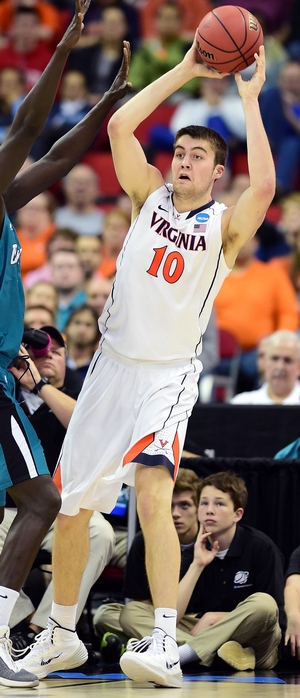
Josh Riddell
Mike Tobey was a key cog in a formidable frontcourt for the Virginia Cavaliers last season and helped lead Virginia to an ACC regular season title, ACC tournament championship and a trip to the Sweet Sixteen. Although he loses running mate Akil Mitchell to graduation, Tobey returns for his junior season hoping to replicate his team's success as a sophomore and lead Virginia back to the NCAA tournament.
After appearing for the U19 USA team in the 2013 FIBA U19 tournament, Tobey saw an uptick in minutes for the Cavaliers in his sophomore season from 13.9 to 18.1. His scoring rate fell off a bit last year, from 21 points per-40 to 15.6, as did his efficiency, from 57% TS% to 51%. With offensive leader Joe Harris also graduated, Tobey may be asked to take on an even larger role in his junior season and will need to show growth to keep scouts interested.
At the USA Basketball camp in 2013, Tobey was measured at 7'0 with shoes, with an impressive 9-1 ½ standing reach. Although he doesn't have a very long wingspan, he has excellent height for a center, and a standing reach equal to recent draftees such as Andre Drummond, Nerlens Noel and Steven Adams, among others. While he has NBA ready size and has improved his frame substantially (now listed at 253 pounds, up from 227 as a freshman) to complement his height, the rest of physical tools are average at best. He doesn't have great explosiveness around the rim and doesn't get up and down the floor all that well. He will need to continue to maximize his frame and athleticism, as he will likely be at a disadvantage physically against some NBA centers who are quicker and better leapers than he is.
Tobey showed a very high skill-level in the post last season, demonstrating an array of moves including a turnaround jump shot, up and under moves, and a hook shot he was comfortable finishing with either hand. While he was able to get position on the block and hold it, he could still add some lower body strength to be able to do so against NBA level centers.
Tobey is just an average passer, only dishing out 11 assists last season in nearly 700 minutes, and can work on this skill for when the defense focuses their attention on him on the post, leaving his teammates free. Being able to recognize the situation and pass out of the post to an open teammate will help improve his efficiency on the block, as he tends to force the issue inside at times.
Tobey is a strong offensive rebounder, as his 4.6 per 40 minutes pace adjusted would rank sixth among all players in our top 100 prospect ranking. His long reach, soft hands, and excellent anticipation skills help him significantly in this area, as he seems to have a great knack for being in the right place at the right time. Unfortunately converting these second-chance opportunities into points is not nearly as much of a strength of his.
Tobey's lack of explosiveness shows in his struggles finishing around the basket, as he converted under 50% of his attempts inside the paint last season, which is extremely poor for a player his size. Tobey relies very heavily on his finesse game inside, and is very much a below the rim player, which is not particularly attractive for the role he'd be asked to play in the NBA. For as skilled a player as Tobey is, shooting 48% from 2-point range again like he did as a sophomore would certainly be a turnoff for scouts.
Conversely, he isn't a productive defensive rebounder, as his 4.5 defensive rebounds per 40 minutes pace adjusted ranked second worst among centers in our top 100. However, part of this can be attributed to playing alongside a strong rebounder in Mitchell, who was often the beneficiary of Tobey boxing out the opposition to give Mitchell a free run to the rebound. With Mitchell no longer a running mate, Tobey will need to step up his production as a defensive rebounder this year. While his explosiveness may hold him back from getting rebounds outside his area, his height and reach should allow him to hold off opponents and corral loose balls that come his way. He has shown potential to improve his production in this area, with a history of getting position on the offensive glass, now he should have an opportunity to see this translate statistically on the defensive end as well.
Elsewhere defensively, Tobey was far from a liability, as he played a solid role on a team that finished miles ahead of anyone in the ACC in defensive efficiency, and ranked top-5 in the country overall. Tobey has excellent fundamentals and obviously very well coached, being patient and intelligent in his approach while playing with solid intensity. His height helps him make up for any physical limitations in back to the basket situations, though, and some added lower body strength should help him become a better defender by not getting pushed around.
How this will translate to the next level is still somewhat up in the air, though, as he lacks the explosiveness to be much of a rim protector and is a target to for isolation plays due to his poor lateral quickness. In today's fast-paced NBA, Tobey will be at a disadvantage athletically, but to his credit, he does a good job of using his size, smarts, length and intensity to try and overcome this as much as he can currently at the college level.
Skilled 7-footers will always get scouted heavily by NBA teams, and even if Tobey has some real holes to his game at the moment, he's extremely young for a junior, just recently turning 20 earlier this month, which easily could have made him a member of the sophomore class.
It will be interesting to see how his athleticism continues to evolve with age, as increasing his rebounding production while becoming a stronger interior finisher are two immediate things Tobey could do to improve his standing in NBA circles. With his solid skill-level and touch, it's not out of the question that Tobey continues to increase the range on his jump-shot, something that would definitely make him more attractive to teams. Tobey has a few skills NBA teams covet in a big man and continuing to round out his skill set will only help his draft stock over the next two years.
#14, Anthony Barber, 6-2, Sophomore, Point Guard, N.C. State
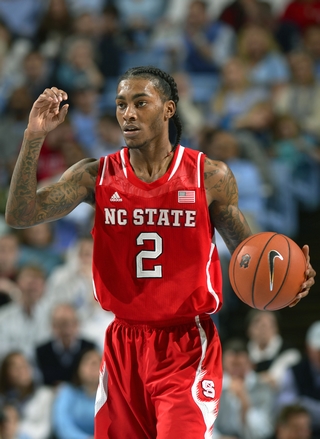
Jonathan Givony
A consensus Top-25 high school recruit, Cat Barber was the fourth McDonald's All-American to commit to N.C. State in the Mark Gottfried era, but is the only one remaining after Tyler Lewis and Rodney Purvis transferred and T.J. Warren left for the NBA.
Measured at 6-2 with a 6-4 wingspan and a 168 pound frame two summers ago at the Lebron James Skills Academy, Barber has good size, average length and a relatively skinny frame that N.C. State now lists at 180 pounds. He's a top-shelf athlete, though, showing one of the quickest first steps in all of college basketball and end to end speed that few can match.
Like his team as a whole, Barber's freshman campaign was somewhat up and down, as he began the season on the bench, then was inserted into the starting lineup after the Wolfpack dropped two of their first four games, only to be relegated back into a reserve role for the final 14 games of the season.
He played 24 minutes per game on average, a fairly significant role for a freshman, splitting ball-handling responsibilities with fellow McDonald's All-American point guard Tyler Lewis, who has since moved onto Butler. Barber was neither an incredibly prolific (14.2 points per-40 minutes) or efficient (48% TS%) scorer, even if he showed promise as a playmaker, dishing out 5.9 assists per-40 minutes with a solid 2/1 assist to turnover ratio and 2.6 pure point rating.
N.C. State played at a relatively slow-tempo last season, and typically resorted to one on one play or off the dribble jumpers when things bogged down, which meant the offense didn't always look like a thing of beauty. Despite the lack of rhythm and cohesiveness the team suffered at times on this end of the floor, Barber still did a solid job of getting his primary scorers T.J. Warren and Ralston Turner the ball in spots they liked to score. While not a brilliant game-manager at this stage, and certainly not immune to making careless mistakes, Barber did a solid job of getting others involved last season, particularly as the year moved on.
Exactly half of Barber's touches last season came either in pick and roll or isolation situations, and he's a terrific ball-handler who is extremely difficult to stay in front of thanks to how shifty and slithery he is creating offense. This comes in very handy in the open floor, where he sees a good amount of his offense as well, and is able to draw fouls on nearly a quarter of his transition opportunities according to Synergy Sports Technology.
While Barber sports a killer crossover and can blow by the opposition at will with his dynamite first step, he doesn't always know what to do once he's past his man. He's not a great finisher around the basket, converting just 46% of his shots inside the paint last season according to Synergy, as his frail frame makes it difficult to make plays in traffic and he does not possess great touch on his floaters or layups. He loves to drive left, but avoids finishing with his left hand like the plague, which makes for some very awkward finishes around the rim that opposing defenses quickly caught onto and looked to exploit regularly last year.
Barber also struggled badly with his jump-shot last season, making just 12 of his 46 (26%) 3-point attempts, causing defenses to go underneath the screen regularly any time he attempted to initiate a pick and roll. Barber tried to punish them by shoot a large volume of off the dribble jumpers, and found mixed results with that strategy, hitting 36% of his pull-ups. While that's a decent percentage for such a difficult shot, at .741 points per possession, it's something opposing defenses were happy to concede to him whenever he wanted.
Improving his outside shot should be a major priority for Barber considering the value NBA teams place on this facet of the game these days. He seemed to be making strides with shooting as his high school career progressed, as he hit 20 of his 47 3-point attempts (43%) in EYBL play the summer prior to his junior year, and then converted 37/88 (42%) prior to his senior year in the same competition. The additional foot of distance and stingier defenses didn't treat him well in moving to the college game, so it will be interesting to see if he can improve this aspect of his game as a sophomore.
Barber actually has decent mechanics on his jumper with time and space, but struggles badly with his accuracy and touch, coming up with some terrible misses last season where he shot the ball way left or right. This is somewhat of a concern, as it's difficult to make too many adjustments to correct this problem, but the small sample size of attempts does leave some room for optimism that he can figure things out eventually, which he'll certainly need to do.
Defensively, Barber has outstanding potential, as he has quick feet and tremendous lateral quickness, giving him the ability to put excellent pressure on the ball. He can hound his man as he brings the ball up the floor, or play excellent one on one defense in the half-court, even if his focus tends to waver somewhat from time to time.
N.C. State had a difficult time stopping their opponents last season, finishing twelfth in the ACC in defensive efficiency, and Barber's lapses here didn't help. Like many young players, he struggles to stay effective defending off the ball, as he loses his intensity as the possession moves on and tends to fall asleep in his stance. His lack of length makes him easy to shoot over and renders him mostly ineffective in closeout situations, and his frail frame makes it difficult for him to fight over screens. Barber has just average fundamentals on this end of the floor, and doesn't always display the type of hustle you'd like to seesomething that is certainly improvable with maturity, good coaching and experience.
With ACC player of the year T.J. Warren off to the NBA, and Tyler Lewis out of the picture, Cat Barber has the reigns to the N.C. State offense all to himself this year, which should tell us quite a bit about what kind of prospect he is long term.
#15, J.P. Tokoto, 6-6, Junior, SG/SF, North Carolina
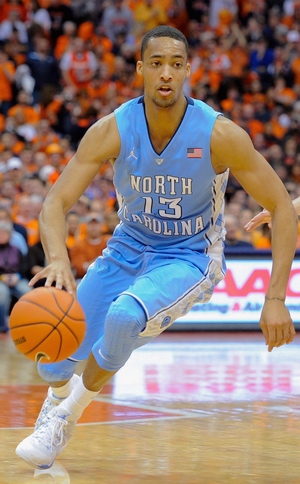
Jonathan Givony
A bit contributor as a freshman at 8.4 minutes per game, J.P. Tokoto became a hugely important player for North Carolina as a sophomore (29 mpg) in the wake of P.J. Hairston's suspension and eventual dismissal, as UNC had absolutely zero depth on the wing.
Not known for his offense, Tokoto was neither a prolific (12.3 points per-40) or efficient (51% TS%) scorer for the Tar Heels, both of which would rank towards the bottom of realistic draft prospects in each respective category.
Standing around 6-6 or possibly 6-7 in shoes, with a 6-9 wingspan, Tokoto has good size for the wing, although average length and strength. He's one of the best athletes in college basketball, though, being amazingly quick, fluid and explosive, making him a fixture on highlight reels with his incredible leaping ability.
Tokoto is a unique offensive playerexceedingly raw from a skills standpoint, but with a surprisingly good feel for passing and getting teammates involved. He does a great job of moving the ball crisply within the flow of offense, finding the open man with impressive creativity, be it by passing ahead in transition, dishing to the weakside cutter, feeding the post, or making the simple extra pass to spot-up shooters (or in UNC's case last season, shooter).
Freakishly athletic players with very limited skill-levels rarely see the floor the way Tokoto does, which leaves a lot of room for optimism regarding his technical ability catching up with his physical tools down the road.
For now, though, Tokoto is very much a limited player in the half-court, struggling to stay effective when he's not finishing around the basket (where he converts an excellent 67% of his attempts) or making plays for others, which hurt UNC's spacing badly last year.
Tokoto possesses very limited range on his jump-shot, only hitting 8 of his 45 (18%) 3-point attempts in his college career thus far. His shooting mechanics are very inconsistent, as he often catches the ball with his legs splayed apart and then elevates with poor balance, a rigid motion and a varying release point, leading to some very bad misses. The fact that Tokoto has only made 58 of his 122 (47.5%) free throw attempts thus far in his career at UNC shows just how much work he has to do on his outside shot, something that will be vital for his chances at carving out a niche in the NBA.
Tokoto also isn't much of a shot-creator at this stage either, as he has very crude ball-handling skills that make it difficult for him to take advantage of his freakish athleticism. When Tokoto can get a step on his man attacking the paint in a straight line, he can be absolutely exhilarating, as he possesses a quick first step, incredibly long strides and outstanding body control, allowing him to simply glide towards the basket and then elevate from tremendous distances for emphatic finishes.
At this stage, though, he struggles badly when a well-organized half-court defense forces him to change directions with the ball, operate at different speeds, or use his left hand, causing him to settle for some very difficult jumpers in the mid-range area.
Being as athletic as he is, and also sporting above average instincts and anticipation skills, Tokoto can make some very impressive plays defensively, particularly in terms of his ability to get in the passing lanes (2.3 steals per-40) or crash the glass (8.1 rebounds per-40, a terrific rate for a wing player). He has the size and quickness to guard up to three positions at the college level, and possibly in the NBA too.
With that said, he's often not quite as good of a defender as he should be considering his physical tools, as he tends to rely too much on his freakish athleticism to get the job done and doesn't show great fundamentals or the highest intensity level. Tokoto gets beat off the dribble a lot more than you'd expect, not fighting through screens (partially due to his relatively weak frame) or closing out with much urgency on the perimeter. He'll need to develop much more of a junkyard dog mentality to maximize his tools on this end of the floor, as he's simply too limited a player offensively to get by operating at half-speed the way he often did last season.
Despite his shortcomings, Tokoto has some impressive gifts that aren't that easy to come by, and will make him a prospect NBA teams will likely continue to track regardless of where he starts his career. If he can find a way to become at least an adequate shooter, and decides to ratchet up the intensity defensively, he could stick around for quite some time, as players with his combination of size, athleticism and passing ability are coveted commodities these days.
#16, Wayne Blackshear, 6'5, Senior, SG/SF, Louisville
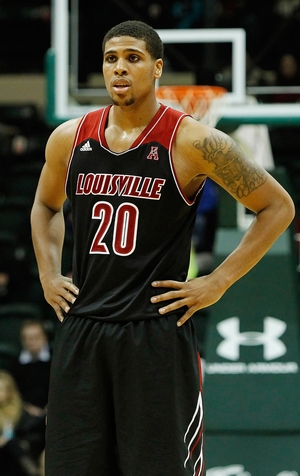
Derek Bodner
As we noted during our last write-up, Wayne Blackshear came to Louisville a highly touted recruit, ranking 21st in his class in the RSCI rankings during his senior season, and a McDonald's All-American. While Blackshear was a solid contributor on the 2013 NCAA Championship squad, he has yet to rise to the level individually that many expected.
For the most part, that continued to be true during his junior season as well. Blackshear actually saw his minutes drop slightly last season, from 20.1 minutes during his sophomore season to 19.6 during his junior year. He remained an important contributor on another deep, talented, and successful Louisville team, but remained a role player.
Blackshear saw a very modest uptick in his per-minute scoring, now up to 16.1 points per 40 minutes pace adjusted, from 14.9 during his sophomore season. Still, having used only 17.5% of Louisville's possessions while he was on the court last season, Blackshear remains one of the lower usage wing prospects.
Offensively, Blackshear's largest contribution remains as a set shooter, and he showed significant improvement in his consistency in this regard. Blackshear shot 39.5% from three point range on 3.2 attempts per game, which makes up over 50% of his overall field goal attempts. Blackshear does a good job with his footwork and positioning before the catch, and has a nice, compact shooting stroke that looks far more consistently repeatable than it was in years past.
Blackshear's other contributions remain largely off the ball, with a combination of cuts to the basket, transition opportunities, and offensive rebounds. On the break, Blackshear is able to either fill the lanes or act as a trailer on the fast break. He's able to finish around the hoop, and is a strong offensive rebounder for somebody who plays about half of his minutes at small forward, playing alongside big men Stephan Van Treese and Harrell. He's able to convert well around the hoop due to his quick jump off of two feet along with his well-developed upper body, and he's able to absorb and finish through contact well for somebody who projects as a wing player at the next level.
Blackshear still remains fairly unrefined as a shot creator. He is able to get into the lane at times, including the use of a good pump fake to get by his initial man, and he has shown some signs of a step back jumper, but overall his ball handling remains fairly basic. While his role with Louisville has largely not demanded that he create frequently for either himself or his teammates, showing the ability to do so this season would help decision makers determine his ultimate upside.
On the defensive side of the court, Blackshear continues to use his physical attributes to his advantage. He has a well-defined upper body with a 6'10.5 wingspan, which should allow him to defend small forwards at the next level, despite measuring in at only 6'5 in shoes. He's done a much better job of being consistently engaged on the defensive side of the court, and maintains a good stance with a low center of gravity, using his length to pester ball handlers on the perimeter. He also looks to be doing a better job of understanding team defensive concepts, doing a much better job of picking the right times to help off the ball. He still continues to pick up fouls too frequently, as he committed 4.6 fouls per 40 minutes pace adjusted, and must do a better job controlling his aggressive defense so he can stay on the court for longer periods of time.
Louisville has had very deep teams over the past few seasons, ranking in the top 15 in both offensive and defensive efficiency each of the last two seasons. While Blackshear's willingness to play the role Louisville needs, and his ability to improve in the facets of the game necessary to be effective in that role, are positive traits when talking about his work ethic and team-first mentality, this makes it relatively difficult to evaluate Blackshear's ultimate upside. With the departure of Russ Smith, there will be more shot creation opportunities in the Louisville offense. We know that Wayne Blackshear can play the role of spot-up shooter, defender, and transition scorerwhich is the type of player NBA teams are increasingly fond of--but it would be interesting to see how well he has advanced as a shot creator as well.













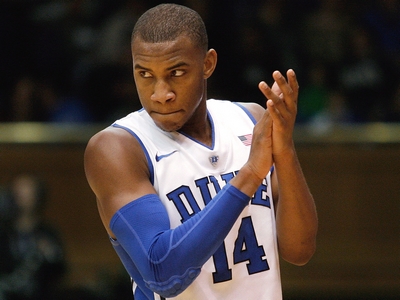



















Comments